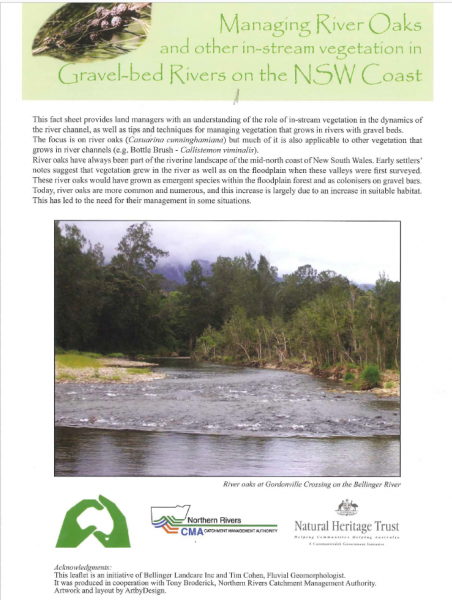 ManagingRiverOaks and other in-stream vegetation
ManagingRiverOaks and other in-stream vegetation
Coast and Estuary Resource Kit – Documentary excerpt from Cross The Line Video Productions on Vimeo.
The Bellinger Coast
The scenic attraction of the coast is largely due to its natual, unspoilt and undeveloped character. The landforms and vegetation of the coast play an important role in protecting inland areas from the natural forces of wind and waves. Coastal vegetation is diverse and highly specialised providing important habitat for animals and resident as well as migratory birds. The public lands which make up our coastal zone, are fragile environments which need active management to ensure their long term integrity.
The diversity and natural values of coastal ecosystems are primarily threatened by weed invasion. Bitou bush is a Weed of ‘National Significance’ which infests significant parts of the 13km Bellinger coastline. It was introduced to stabilise dune areas after sand mining. Bitou invades native vegetation and forms a monoculture inhibiting native regeneration. Other significant weeds in the coastal environment include lantana, glory lily and winter senna.
Four volunteer coastal care groups are at Tuckers Rocks, Urunga Landcare, Mylestom and Wenonah Head. Bellinger Landcare coordinates these groups’ activites with Bellingen Shire Council and the Land and Property Management Authority coastal weed control programs to ensure coastal areas with high conservation value have weed control and habitat restoration projects implemented.
The Bellinger and Kalang Estuaries
The estuary is the part of a river system where salt and fresh water mix. The estuaries of the Bellinger and Kalang rivers extend inland approximately 24 km to Bellingen and Brierfield respectively.
Estuaries are diverse and dynamic places supporting a wide range of often highly specialised animal and plant life. Deposition of sediment and pollutants from further upstream can occur here and estuarine ecosystems have an important role in recycling and stabilising sediments and pollution.
Because of their position at the lower end of the catchment, the fertile floodplain soils, intensive land use and trends towards increased coastal living, human impacts on estuaries can be significant. Recreational use of estuaries is increasing and activities such as fishing, swimming and boating can have their own impacts on estuarine health.
Bellingen Shire Council has developed an Estuary Management Plan for the Bellingen and Kalang Rivers through its Coastline and Estuary Management Committee. The plan identifies issues which need active management and proposes management strategies to ensure the sustainability of the estuaries.
Key management issues are:
- river bank erosion
- minimising impacts of recreational use
- ensuring good water quality for human recreation, ecological processes & to support the oyster industry.
